airbag off BMW ACTIVE HYBRID 5 2014 F10H Owner's Manual
[x] Cancel search | Manufacturer: BMW, Model Year: 2014, Model line: ACTIVE HYBRID 5, Model: BMW ACTIVE HYBRID 5 2014 F10HPages: 251, PDF Size: 5.36 MB
Page 13 of 251
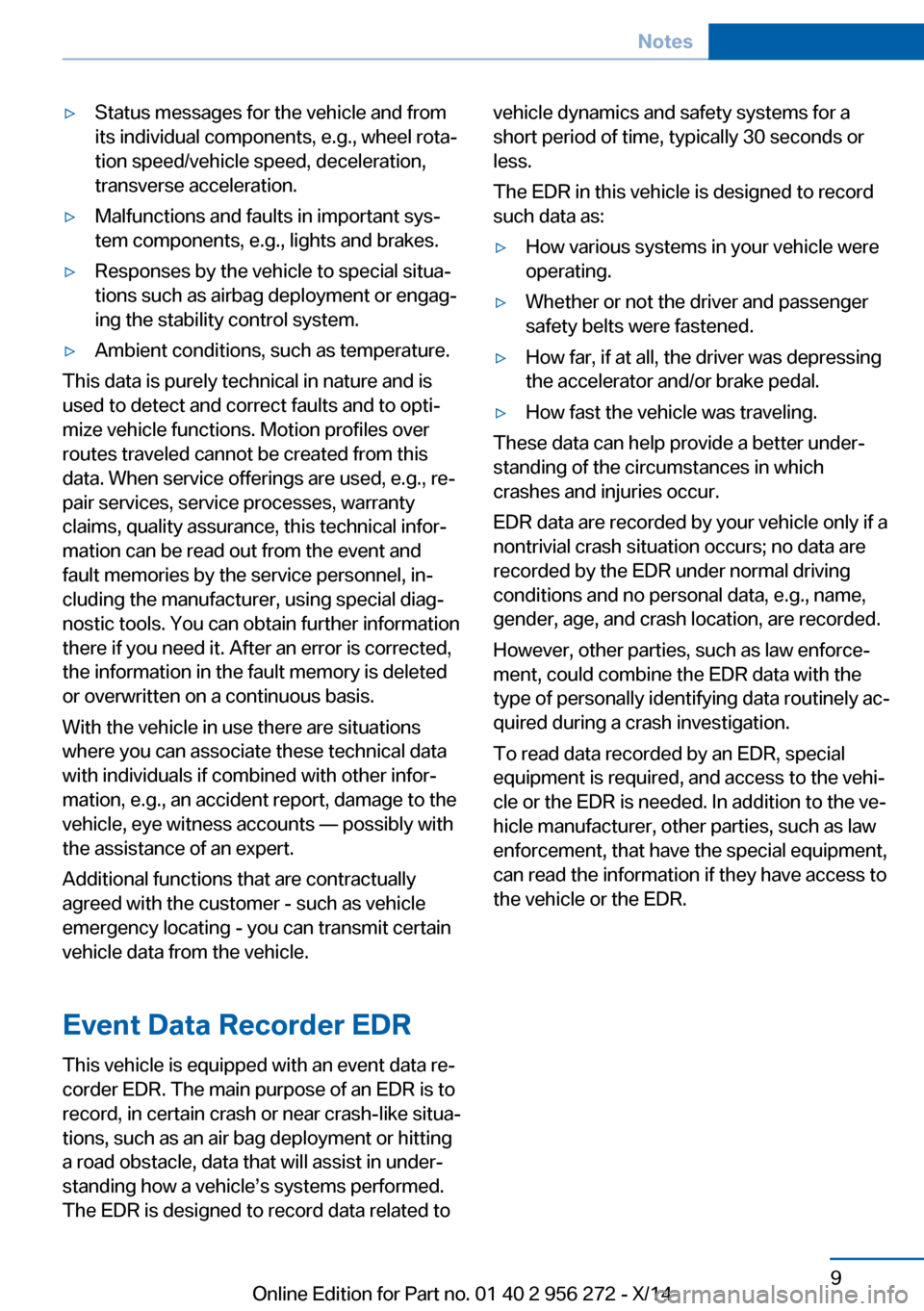
▷Status messages for the vehicle and from
its individual components, e.g., wheel rota‐
tion speed/vehicle speed, deceleration,
transverse acceleration.▷Malfunctions and faults in important sys‐
tem components, e.g., lights and brakes.▷Responses by the vehicle to special situa‐
tions such as airbag deployment or engag‐
ing the stability control system.▷Ambient conditions, such as temperature.
This data is purely technical in nature and is
used to detect and correct faults and to opti‐
mize vehicle functions. Motion profiles over
routes traveled cannot be created from this
data. When service offerings are used, e.g., re‐
pair services, service processes, warranty
claims, quality assurance, this technical infor‐
mation can be read out from the event and
fault memories by the service personnel, in‐
cluding the manufacturer, using special diag‐
nostic tools. You can obtain further information
there if you need it. After an error is corrected,
the information in the fault memory is deleted
or overwritten on a continuous basis.
With the vehicle in use there are situations
where you can associate these technical data
with individuals if combined with other infor‐
mation, e.g., an accident report, damage to the
vehicle, eye witness accounts — possibly with
the assistance of an expert.
Additional functions that are contractually
agreed with the customer - such as vehicle
emergency locating - you can transmit certain
vehicle data from the vehicle.
Event Data Recorder EDR
This vehicle is equipped with an event data re‐
corder EDR. The main purpose of an EDR is to
record, in certain crash or near crash-like situa‐
tions, such as an air bag deployment or hitting
a road obstacle, data that will assist in under‐
standing how a vehicle’s systems performed.
The EDR is designed to record data related to
vehicle dynamics and safety systems for a
short period of time, typically 30 seconds or
less.
The EDR in this vehicle is designed to record
such data as:▷How various systems in your vehicle were
operating.▷Whether or not the driver and passenger
safety belts were fastened.▷How far, if at all, the driver was depressing
the accelerator and/or brake pedal.▷How fast the vehicle was traveling.
These data can help provide a better under‐
standing of the circumstances in which
crashes and injuries occur.
EDR data are recorded by your vehicle only if a
nontrivial crash situation occurs; no data are
recorded by the EDR under normal driving
conditions and no personal data, e.g., name,
gender, age, and crash location, are recorded.
However, other parties, such as law enforce‐
ment, could combine the EDR data with the
type of personally identifying data routinely ac‐
quired during a crash investigation.
To read data recorded by an EDR, special
equipment is required, and access to the vehi‐
cle or the EDR is needed. In addition to the ve‐
hicle manufacturer, other parties, such as law
enforcement, that have the special equipment,
can read the information if they have access to
the vehicle or the EDR.
Seite 9Notes9
Online Edition for Part no. 01 40 2 956 272 - X/14
Page 59 of 251
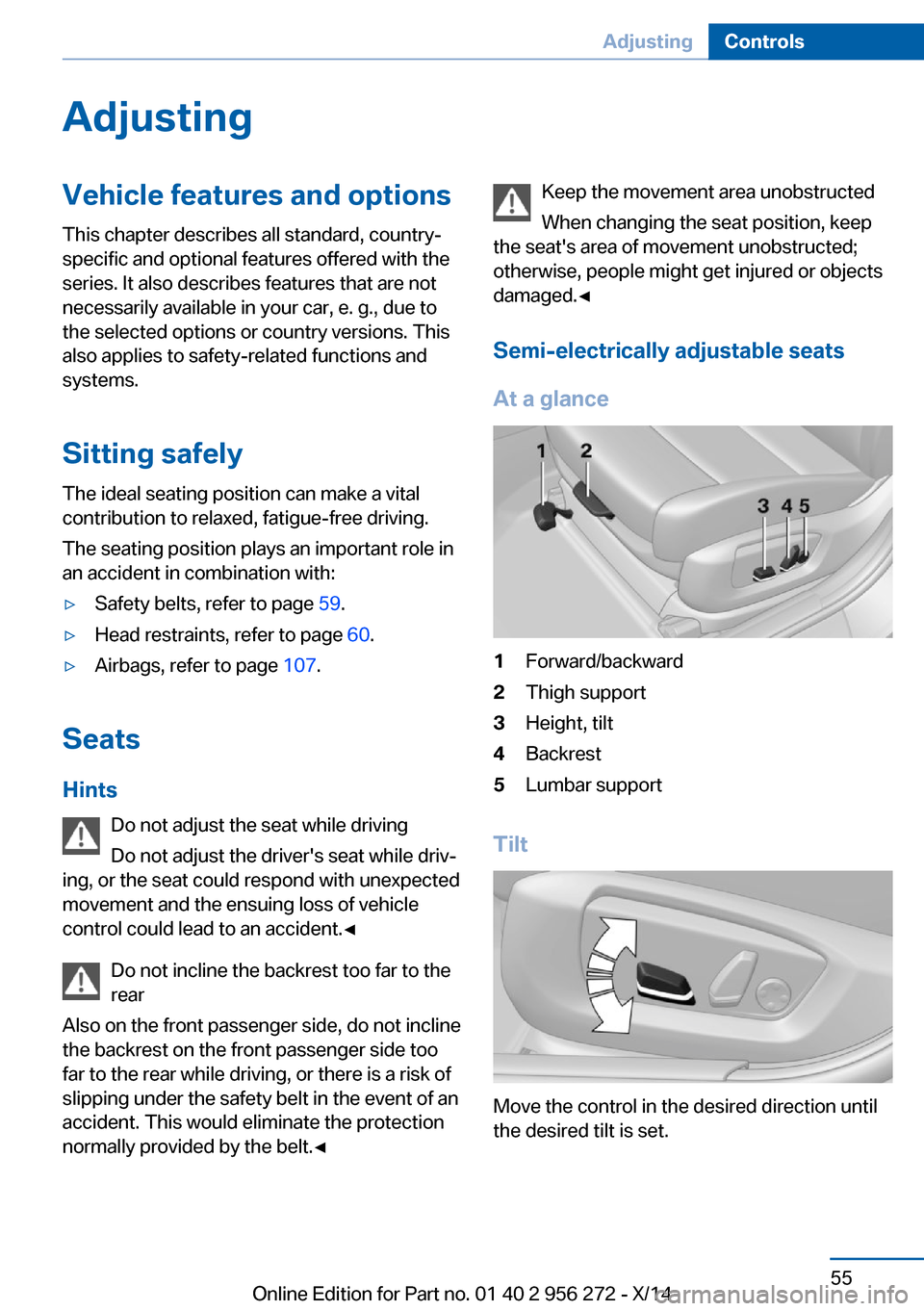
AdjustingVehicle features and options
This chapter describes all standard, country-
specific and optional features offered with the
series. It also describes features that are not
necessarily available in your car, e. g., due to
the selected options or country versions. This
also applies to safety-related functions and
systems.
Sitting safely
The ideal seating position can make a vital
contribution to relaxed, fatigue-free driving.
The seating position plays an important role in
an accident in combination with:▷Safety belts, refer to page 59.▷Head restraints, refer to page 60.▷Airbags, refer to page 107.
Seats
Hints Do not adjust the seat while driving
Do not adjust the driver's seat while driv‐
ing, or the seat could respond with unexpected
movement and the ensuing loss of vehicle
control could lead to an accident.◀
Do not incline the backrest too far to the
rear
Also on the front passenger side, do not incline
the backrest on the front passenger side too far to the rear while driving, or there is a risk of
slipping under the safety belt in the event of an
accident. This would eliminate the protection
normally provided by the belt.◀
Keep the movement area unobstructed
When changing the seat position, keep
the seat's area of movement unobstructed;
otherwise, people might get injured or objects
damaged.◀
Semi-electrically adjustable seatsAt a glance1Forward/backward2Thigh support3Height, tilt4Backrest5Lumbar support
Tilt
Move the control in the desired direction until
the desired tilt is set.
Seite 55AdjustingControls55
Online Edition for Part no. 01 40 2 956 272 - X/14
Page 63 of 251

The maximum temperature is reached when
three LEDs are lit.
If the journey is continued within approx. 15
minutes, the seat heating is activated automat‐
ically with the temperature selected last.
When ECO PRO, refer to page 189, is acti‐
vated, the heater output is reduced.
Switch off Press button longer.
The LEDs go out.
Active seat ventilation, front The seat cushion and backrest surfaces are
cooled by means of integrated fans.
The ventilation cools the seat, e. g., if the vehi‐
cle interior is overheated or for continuous
cooling at high temperatures.
Switching on
Press button once for each ventilation
level.
The highest level is active when three LEDs
are lit.
After a short time, the system automatically
moves down one level in order to prevent ex‐
cessive cooling.
Switch off Press button longer.
The LEDs go out.
Safety belts
Seats with safety belt
The vehicle has five seats, each of which is
equipped with a safety belt.
General information
Always make sure that safety belts are being
worn by all occupants before driving off.
For the occupants' safety the belt locking
mechanism triggers early. Slowly guide the
belt out of the holder when applying it.
Although airbags enhance safety by providing
added protection, they are not a substitute for
safety belts.
The upper shoulder strap's anchorage point
will be correct for adult seat occupants of ev‐
ery build if the seat is correctly adjusted.▷The two outer safety belt buckles,
integrated into the rear seat, are for pas‐
sengers sitting on the left and right.▷The center rear safety belt buckle is solely
intended for the center passenger.
Hints
One person per safety belt
Never allow more than one person to
wear a single safety belt. Never allow infants or
small children to ride on a passenger's lap.◀
Putting on the belt
Lay the belt, without twisting, snugly
across the lap and shoulders, as close to the
body as possible. Make sure that the belt lies
low around the hips in the lap area and does
not press on the abdomen. Otherwise, the belt
can slip over the hips in a frontal impact and in‐
jure the abdomen.
The safety belt must not lie across the neck,
rub on sharp edges, be routed over breakable
objects, or be pinched.◀
Seite 59AdjustingControls59
Online Edition for Part no. 01 40 2 956 272 - X/14
Page 71 of 251
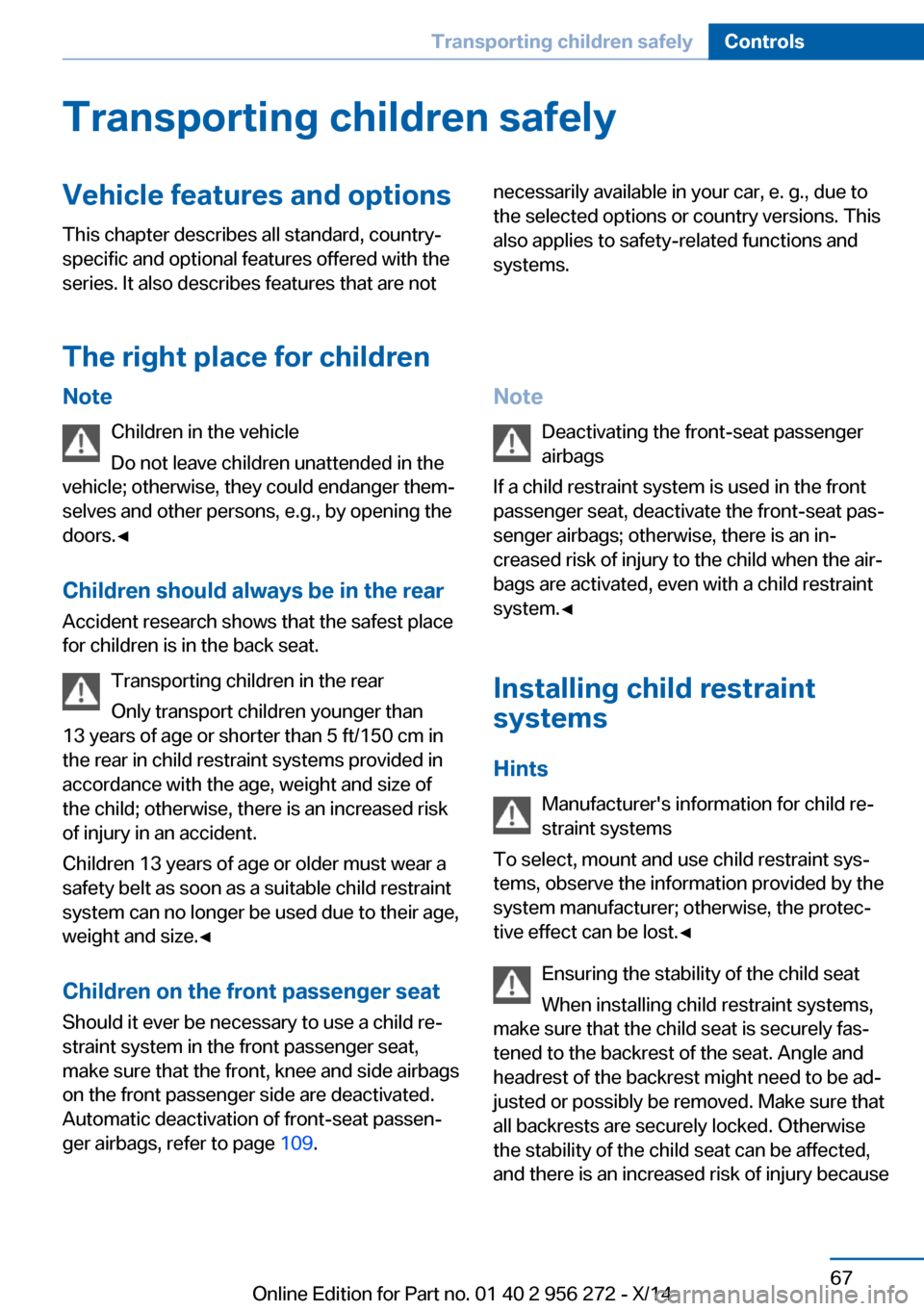
Transporting children safelyVehicle features and optionsThis chapter describes all standard, country-
specific and optional features offered with the
series. It also describes features that are notnecessarily available in your car, e. g., due to
the selected options or country versions. This
also applies to safety-related functions and
systems.
The right place for children
Note
Children in the vehicle
Do not leave children unattended in the
vehicle; otherwise, they could endanger them‐
selves and other persons, e.g., by opening the
doors.◀
Children should always be in the rear Accident research shows that the safest place
for children is in the back seat.
Transporting children in the rear
Only transport children younger than
13 years of age or shorter than 5 ft/150 cm in
the rear in child restraint systems provided in
accordance with the age, weight and size of
the child; otherwise, there is an increased risk
of injury in an accident.
Children 13 years of age or older must wear a
safety belt as soon as a suitable child restraint
system can no longer be used due to their age,
weight and size.◀
Children on the front passenger seat
Should it ever be necessary to use a child re‐
straint system in the front passenger seat,
make sure that the front, knee and side airbags
on the front passenger side are deactivated.
Automatic deactivation of front-seat passen‐
ger airbags, refer to page 109.Note
Deactivating the front-seat passenger
airbags
If a child restraint system is used in the front
passenger seat, deactivate the front-seat pas‐
senger airbags; otherwise, there is an in‐
creased risk of injury to the child when the air‐
bags are activated, even with a child restraint
system.◀
Installing child restraint
systems
Hints Manufacturer's information for child re‐straint systems
To select, mount and use child restraint sys‐
tems, observe the information provided by the
system manufacturer; otherwise, the protec‐
tive effect can be lost.◀
Ensuring the stability of the child seat
When installing child restraint systems,
make sure that the child seat is securely fas‐
tened to the backrest of the seat. Angle and
headrest of the backrest might need to be ad‐
justed or possibly be removed. Make sure that
all backrests are securely locked. Otherwise
the stability of the child seat can be affected,
and there is an increased risk of injury becauseSeite 67Transporting children safelyControls67
Online Edition for Part no. 01 40 2 956 272 - X/14
Page 72 of 251
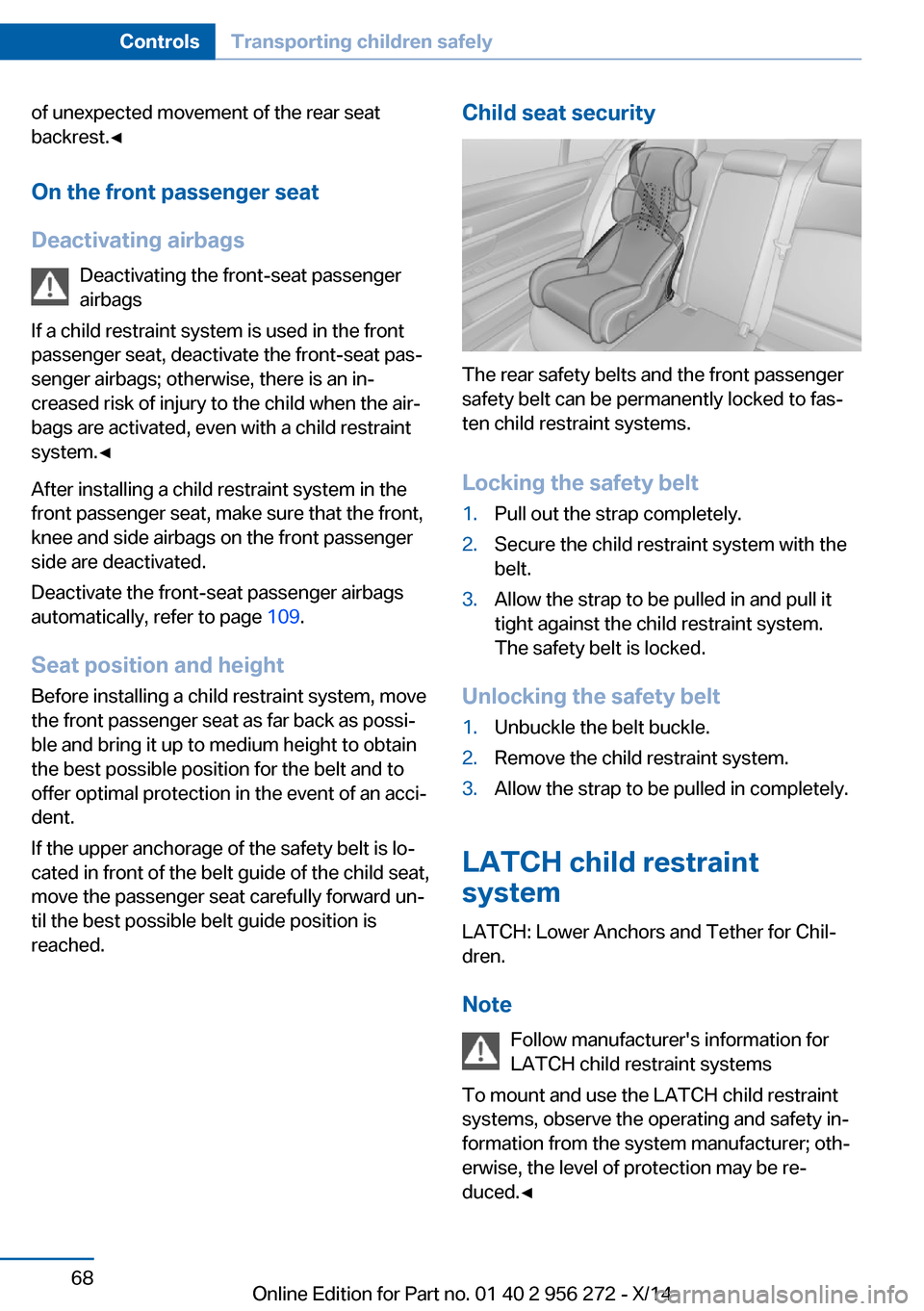
of unexpected movement of the rear seat
backrest.◀
On the front passenger seat
Deactivating airbags Deactivating the front-seat passenger
airbags
If a child restraint system is used in the front
passenger seat, deactivate the front-seat pas‐
senger airbags; otherwise, there is an in‐
creased risk of injury to the child when the air‐
bags are activated, even with a child restraint
system.◀
After installing a child restraint system in the
front passenger seat, make sure that the front,
knee and side airbags on the front passenger
side are deactivated.
Deactivate the front-seat passenger airbags
automatically, refer to page 109.
Seat position and height
Before installing a child restraint system, move
the front passenger seat as far back as possi‐
ble and bring it up to medium height to obtain
the best possible position for the belt and to
offer optimal protection in the event of an acci‐
dent.
If the upper anchorage of the safety belt is lo‐
cated in front of the belt guide of the child seat,
move the passenger seat carefully forward un‐
til the best possible belt guide position is
reached.Child seat security
The rear safety belts and the front passenger
safety belt can be permanently locked to fas‐
ten child restraint systems.
Locking the safety belt
1.Pull out the strap completely.2.Secure the child restraint system with the
belt.3.Allow the strap to be pulled in and pull it
tight against the child restraint system.
The safety belt is locked.
Unlocking the safety belt
1.Unbuckle the belt buckle.2.Remove the child restraint system.3.Allow the strap to be pulled in completely.
LATCH child restraint
system
LATCH: Lower Anchors and Tether for Chil‐
dren.
Note Follow manufacturer's information for
LATCH child restraint systems
To mount and use the LATCH child restraint
systems, observe the operating and safety in‐
formation from the system manufacturer; oth‐
erwise, the level of protection may be re‐
duced.◀
Seite 68ControlsTransporting children safely68
Online Edition for Part no. 01 40 2 956 272 - X/14
Page 111 of 251
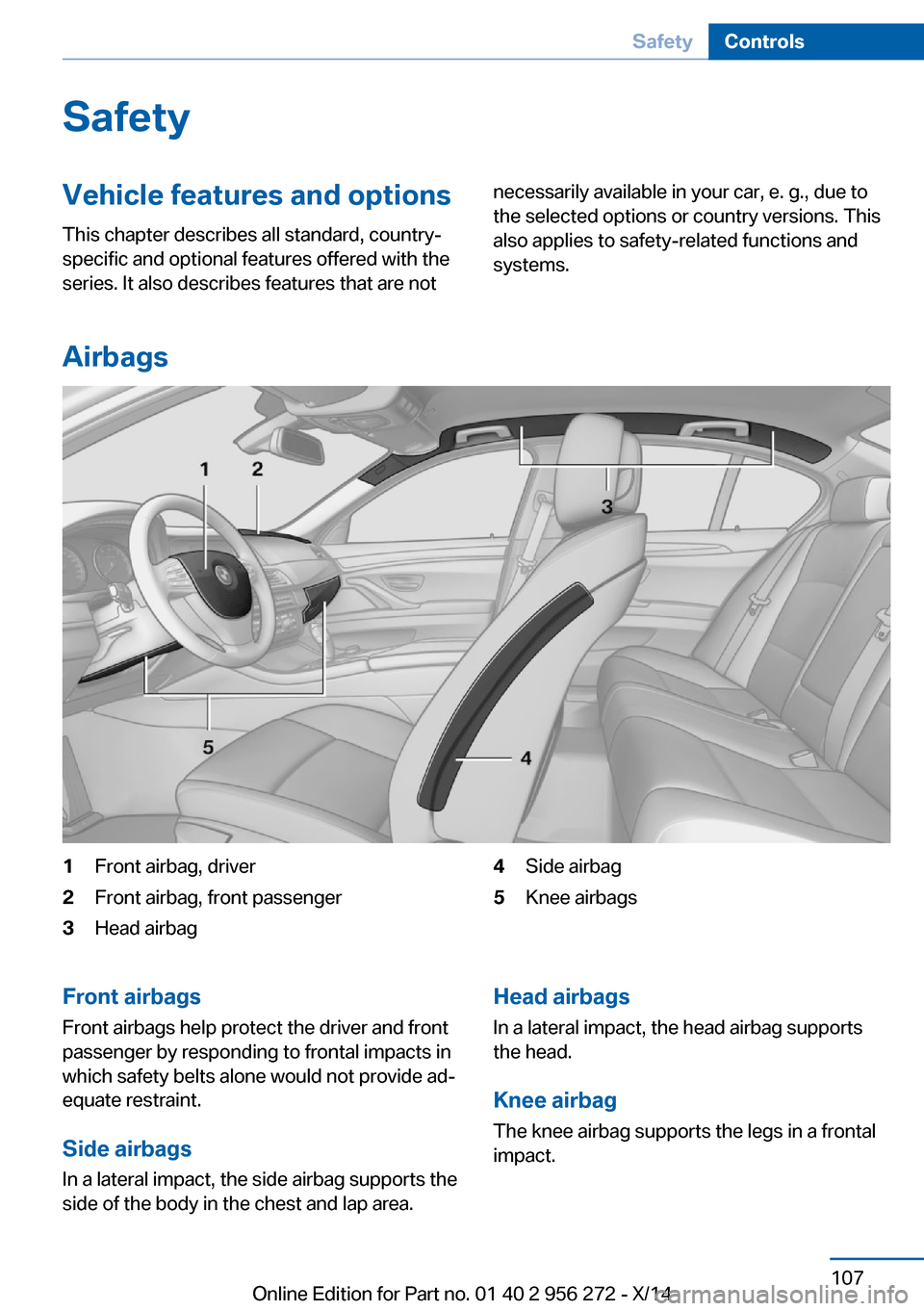
SafetyVehicle features and options
This chapter describes all standard, country-
specific and optional features offered with the
series. It also describes features that are notnecessarily available in your car, e. g., due to
the selected options or country versions. This
also applies to safety-related functions and
systems.
Airbags
1Front airbag, driver2Front airbag, front passenger3Head airbag4Side airbag5Knee airbagsFront airbags
Front airbags help protect the driver and front
passenger by responding to frontal impacts in
which safety belts alone would not provide ad‐
equate restraint.
Side airbags
In a lateral impact, the side airbag supports the
side of the body in the chest and lap area.Head airbags
In a lateral impact, the head airbag supports
the head.
Knee airbagThe knee airbag supports the legs in a frontal
impact.Seite 107SafetyControls107
Online Edition for Part no. 01 40 2 956 272 - X/14
Page 240 of 251

Everything from A to Z
IndexA ABS, Antilock Brake Sys‐ tem 134
ACC, Active Cruise Control with Stop & Go 139
Activated-charcoal filter 163
Activate drive readiness 72
Active Blind Spot Detec‐ tion 129
Active Cruise Control with Stop & Go, ACC 139
ActiveHybrid, system 31
Active Protection 131
Active seat, front 58
Active seat ventilation, front 59
Adapting to the course of the road, hybrid system 88
Adaptive brake assistant 134
Adaptive brake lights, refer to Brake force display 131
Adaptive Light Control 103
Additives, oil 209
Adjustments, seats/head re‐ straints 55
After washing vehicle 229
Airbags 107
Airbags, indicator/warning light 108
Air circulation, refer to Recir‐ culated-air mode 162
Air, dehumidifying, refer to Cooling function 162
Air distribution, manual 161
Air flow, automatic climate control 161
Air outlets, see ventila‐ tion 163
Air pressure, tires 198
Alarm system 49 Alarm, unintentional 50
All around the center con‐ sole 16
All around the roofliner 17
All around the steering wheel 14
All-season tires, refer to Win‐ ter tires 204
Alternating-code hand-held transmitter 169
Alternative oil types 210
Ambient light 105
Animal detection, see Night Vision 124
Antifreeze, washer fluid 81
Antilock Brake System, ABS 134
Anti-slip control, refer to DSC 134
Approved axle load 235
Approved engine oils 210
Armrest, refer to Center arm‐ rest 175
Arrival time 97
Ashtray 170
Ashtray, front 170
Ashtray, rear 171
Assistance for the combus‐ tion engine, ASSIST 75
Assistance for the combus‐ tion engine, eBOOST 75
Assistance, Roadside Assis‐ tance 223
Assistance when driving off 134
ASSIST, assistance for the combustion engine 75
Attentiveness assistant 131
AUTO H button 76
AUTO H button, refer to Au‐ tomatic Hold 76 AUTO intensity 161
Automatic car wash 228
Automatic climate con‐ trol 160
Automatic Cruise Control with Stop & Go 139
Automatic Curb Monitor 64
Automatic deactivation, front- seat passenger airbags 109
Automatic deactivation of the hybrid system 227
Automatic engine start-stop function 73
Automatic headlight con‐ trol 103
Automatic Hold 76
Automatic locking 48
Automatic recirculated-air control 162
Automatic Soft Closing, doors 42
Automatic transmission, see Steptronic transmission 81
Automatic trunk lid 43
AUTO program, automatic cli‐ mate control 161
AUTO program, intensity 161
Auxiliary air conditioning 167
Average fuel consumption 97
Average speed 97
Axle loads, weights 235
B Backrest curvature, refer to Lumbar support 57
Backrest, width 57
Band-aids, refer to First aid kit 223
Bar for tow-starting/ towing 225 Seite 236ReferenceEverything from A to Z236
Online Edition for Part no. 01 40 2 956 272 - X/14
Page 243 of 251
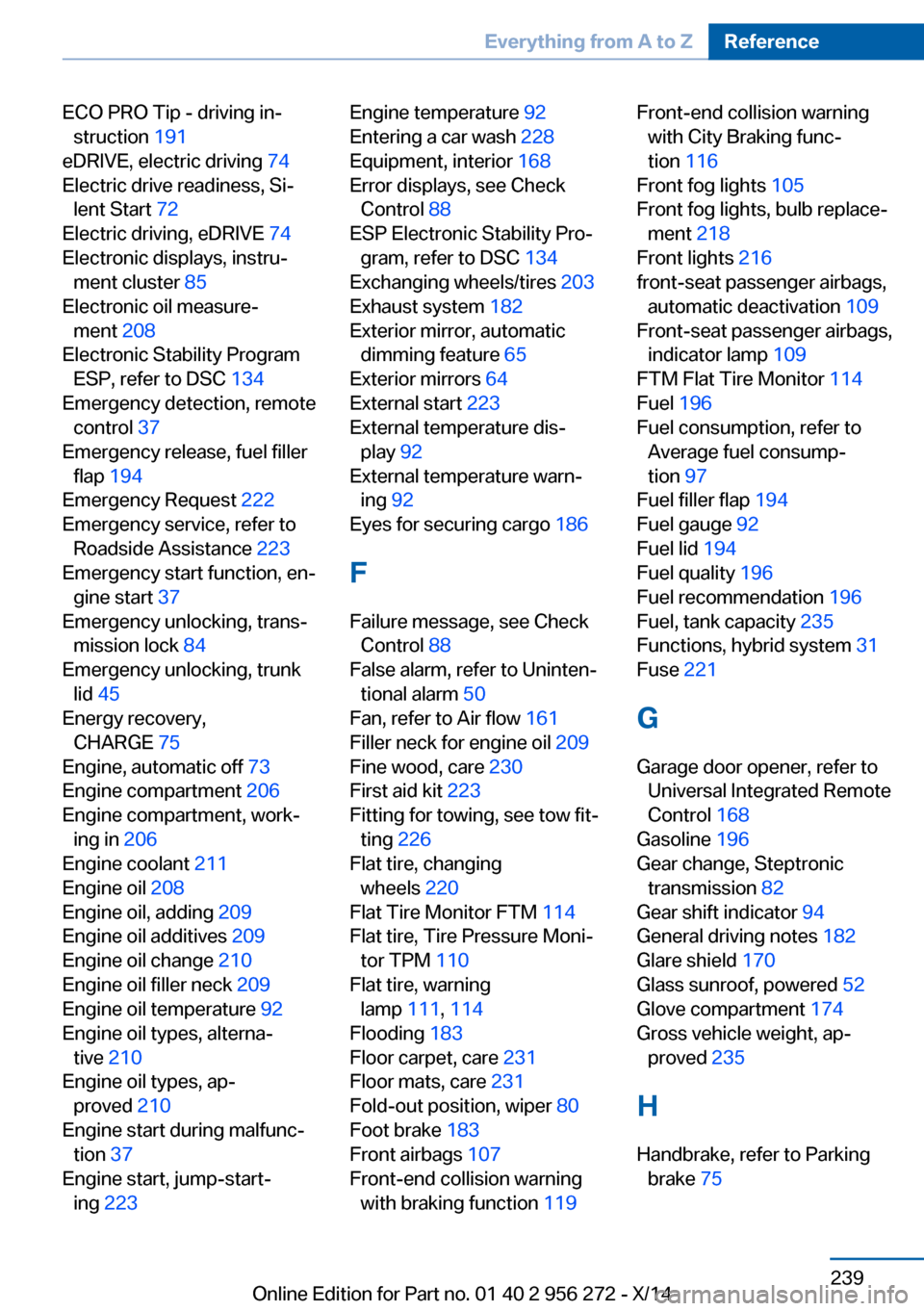
ECO PRO Tip - driving in‐struction 191
eDRIVE, electric driving 74
Electric drive readiness, Si‐ lent Start 72
Electric driving, eDRIVE 74
Electronic displays, instru‐ ment cluster 85
Electronic oil measure‐ ment 208
Electronic Stability Program ESP, refer to DSC 134
Emergency detection, remote control 37
Emergency release, fuel filler flap 194
Emergency Request 222
Emergency service, refer to Roadside Assistance 223
Emergency start function, en‐ gine start 37
Emergency unlocking, trans‐ mission lock 84
Emergency unlocking, trunk lid 45
Energy recovery, CHARGE 75
Engine, automatic off 73
Engine compartment 206
Engine compartment, work‐ ing in 206
Engine coolant 211
Engine oil 208
Engine oil, adding 209
Engine oil additives 209
Engine oil change 210
Engine oil filler neck 209
Engine oil temperature 92
Engine oil types, alterna‐ tive 210
Engine oil types, ap‐ proved 210
Engine start during malfunc‐ tion 37
Engine start, jump-start‐ ing 223 Engine temperature 92
Entering a car wash 228
Equipment, interior 168
Error displays, see Check Control 88
ESP Electronic Stability Pro‐ gram, refer to DSC 134
Exchanging wheels/tires 203
Exhaust system 182
Exterior mirror, automatic dimming feature 65
Exterior mirrors 64
External start 223
External temperature dis‐ play 92
External temperature warn‐ ing 92
Eyes for securing cargo 186
F
Failure message, see Check Control 88
False alarm, refer to Uninten‐ tional alarm 50
Fan, refer to Air flow 161
Filler neck for engine oil 209
Fine wood, care 230
First aid kit 223
Fitting for towing, see tow fit‐ ting 226
Flat tire, changing wheels 220
Flat Tire Monitor FTM 114
Flat tire, Tire Pressure Moni‐ tor TPM 110
Flat tire, warning lamp 111, 114
Flooding 183
Floor carpet, care 231
Floor mats, care 231
Fold-out position, wiper 80
Foot brake 183
Front airbags 107
Front-end collision warning with braking function 119 Front-end collision warning
with City Braking func‐
tion 116
Front fog lights 105
Front fog lights, bulb replace‐ ment 218
Front lights 216
front-seat passenger airbags, automatic deactivation 109
Front-seat passenger airbags, indicator lamp 109
FTM Flat Tire Monitor 114
Fuel 196
Fuel consumption, refer to Average fuel consump‐
tion 97
Fuel filler flap 194
Fuel gauge 92
Fuel lid 194
Fuel quality 196
Fuel recommendation 196
Fuel, tank capacity 235
Functions, hybrid system 31
Fuse 221
G
Garage door opener, refer to Universal Integrated Remote
Control 168
Gasoline 196
Gear change, Steptronic transmission 82
Gear shift indicator 94
General driving notes 182
Glare shield 170
Glass sunroof, powered 52
Glove compartment 174
Gross vehicle weight, ap‐ proved 235
H
Handbrake, refer to Parking brake 75 Seite 239Everything from A to ZReference239
Online Edition for Part no. 01 40 2 956 272 - X/14
Page 244 of 251
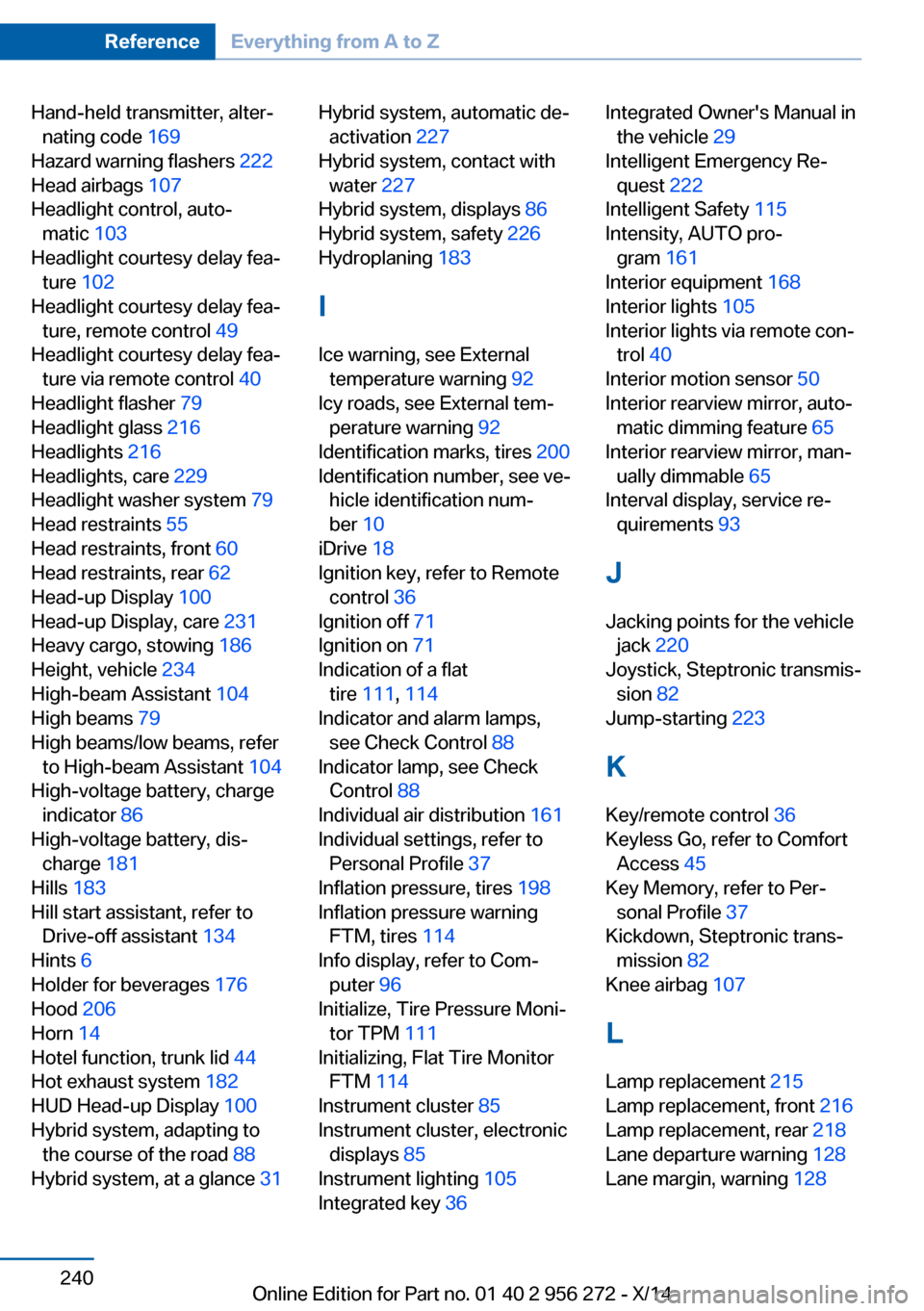
Hand-held transmitter, alter‐nating code 169
Hazard warning flashers 222
Head airbags 107
Headlight control, auto‐ matic 103
Headlight courtesy delay fea‐ ture 102
Headlight courtesy delay fea‐ ture, remote control 49
Headlight courtesy delay fea‐ ture via remote control 40
Headlight flasher 79
Headlight glass 216
Headlights 216
Headlights, care 229
Headlight washer system 79
Head restraints 55
Head restraints, front 60
Head restraints, rear 62
Head-up Display 100
Head-up Display, care 231
Heavy cargo, stowing 186
Height, vehicle 234
High-beam Assistant 104
High beams 79
High beams/low beams, refer to High-beam Assistant 104
High-voltage battery, charge indicator 86
High-voltage battery, dis‐ charge 181
Hills 183
Hill start assistant, refer to Drive-off assistant 134
Hints 6
Holder for beverages 176
Hood 206
Horn 14
Hotel function, trunk lid 44
Hot exhaust system 182
HUD Head-up Display 100
Hybrid system, adapting to the course of the road 88
Hybrid system, at a glance 31 Hybrid system, automatic de‐
activation 227
Hybrid system, contact with water 227
Hybrid system, displays 86
Hybrid system, safety 226
Hydroplaning 183
I Ice warning, see External temperature warning 92
Icy roads, see External tem‐ perature warning 92
Identification marks, tires 200
Identification number, see ve‐ hicle identification num‐
ber 10
iDrive 18
Ignition key, refer to Remote control 36
Ignition off 71
Ignition on 71
Indication of a flat tire 111 , 114
Indicator and alarm lamps, see Check Control 88
Indicator lamp, see Check Control 88
Individual air distribution 161
Individual settings, refer to Personal Profile 37
Inflation pressure, tires 198
Inflation pressure warning FTM, tires 114
Info display, refer to Com‐ puter 96
Initialize, Tire Pressure Moni‐ tor TPM 111
Initializing, Flat Tire Monitor FTM 114
Instrument cluster 85
Instrument cluster, electronic displays 85
Instrument lighting 105
Integrated key 36 Integrated Owner's Manual in
the vehicle 29
Intelligent Emergency Re‐ quest 222
Intelligent Safety 115
Intensity, AUTO pro‐ gram 161
Interior equipment 168
Interior lights 105
Interior lights via remote con‐ trol 40
Interior motion sensor 50
Interior rearview mirror, auto‐ matic dimming feature 65
Interior rearview mirror, man‐ ually dimmable 65
Interval display, service re‐ quirements 93
J Jacking points for the vehicle jack 220
Joystick, Steptronic transmis‐ sion 82
Jump-starting 223
K
Key/remote control 36
Keyless Go, refer to Comfort Access 45
Key Memory, refer to Per‐ sonal Profile 37
Kickdown, Steptronic trans‐ mission 82
Knee airbag 107
L Lamp replacement 215
Lamp replacement, front 216
Lamp replacement, rear 218
Lane departure warning 128
Lane margin, warning 128 Seite 240ReferenceEverything from A to Z240
Online Edition for Part no. 01 40 2 956 272 - X/14